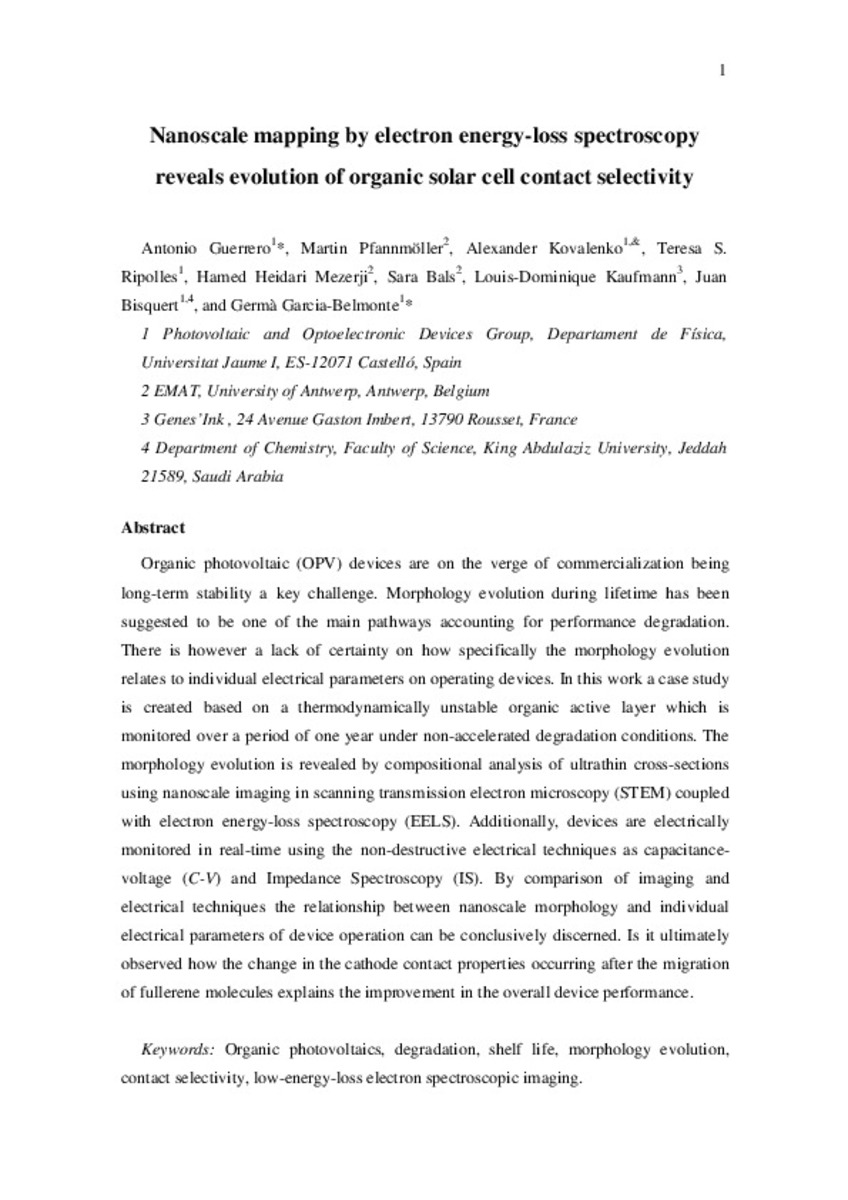Mostrar el registro sencillo del ítem
Nanoscale mapping by electron energy-loss spectroscopy reveals evolution of organic solar cell contact selectivity
| dc.contributor.author | Guerrero, Antonio | |
| dc.contributor.author | Pfannmöller, Martin | |
| dc.contributor.author | Kovalenko, Alexander | |
| dc.contributor.author | Ripollés Sanchis, Teresa | |
| dc.contributor.author | Heidari, Hamed | |
| dc.contributor.author | Bals, Sara | |
| dc.contributor.author | Kaufmann, Louis-Dominique | |
| dc.contributor.author | Bisquert, Juan | |
| dc.contributor.author | Garcia-Belmonte, Germà | |
| dc.date.accessioned | 2016-02-23T15:35:26Z | |
| dc.date.available | 2016-02-23T15:35:26Z | |
| dc.date.issued | 2015 | |
| dc.identifier.issn | 1566-1199 | |
| dc.identifier.issn | 1878-5530 | |
| dc.identifier.uri | http://hdl.handle.net/10234/151213 | |
| dc.description.abstract | Organic photovoltaic (OPV) devices are on the verge of commercialization being long-term stability a key challenge. Morphology evolution during lifetime has been suggested to be one of the main pathways accounting for performance degradation. There is however a lack of certainty on how specifically the morphology evolution relates to individual electrical parameters on operating devices. In this work a case study is created based on a thermodynamically unstable organic active layer which is monitored over a period of one year under non-accelerated degradation conditions. The morphology evolution is revealed by compositional analysis of ultrathin cross-sections using nanoscale imaging in scanning transmission electron microscopy (STEM) coupled with electron energy-loss spectroscopy (EELS). Additionally, devices are electrically monitored in real-time using the non-destructive electrical techniques capacitance–voltage (C–V) and Impedance Spectroscopy (IS). By comparison of imaging and electrical techniques the relationship between nanoscale morphology and individual electrical parameters of device operation can be conclusively discerned. It is ultimately observed how the change in the cathode contact properties occurring after the migration of fullerene molecules explains the improvement in the overall device performance. | ca_CA |
| dc.description.sponsorShip | FP7 European collaborative project SUNFLOWER (FP7-ICT). 287594 Generalitat Valenciana (Institute of Nanotechnologies for Clean Energies). ISIC/2012/008 European Research Council (ERC). 335078-COLOURATOMS Brno University of Technology. CZ.1.07/2.3.00/30.0039 SIM NanoForce program | ca_CA |
| dc.format.extent | 24 p. | ca_CA |
| dc.format.mimetype | application/pdf | ca_CA |
| dc.language.iso | eng | ca_CA |
| dc.publisher | Elsevier | ca_CA |
| dc.relation.isPartOf | Organic Electronics 16 (2015) 227–233 | ca_CA |
| dc.rights | © 2014 Elsevier B.V. All rights reserved. | ca_CA |
| dc.rights.uri | http://rightsstatements.org/vocab/InC/1.0/ | * |
| dc.subject | Organic photovoltaics | ca_CA |
| dc.subject | degradation | ca_CA |
| dc.subject | shelf life | ca_CA |
| dc.subject | morphology evolution | ca_CA |
| dc.subject | contact selectivity | ca_CA |
| dc.subject | low-energy-loss electron spectroscopic imaging | ca_CA |
| dc.title | Nanoscale mapping by electron energy-loss spectroscopy reveals evolution of organic solar cell contact selectivity | ca_CA |
| dc.type | info:eu-repo/semantics/article | ca_CA |
| dc.identifier.doi | http://dx.doi.org/10.1016/j.orgel.2014.11.007 | |
| dc.rights.accessRights | info:eu-repo/semantics/openAccess | ca_CA |
| dc.relation.publisherVersion | http://ac.els-cdn.com/S1566119914005102/1-s2.0-S1566119914005102-main.pdf?_tid=dc071636-da3b-11e5-819d-00000aacb361&acdnat=1456238813_250184b24adc2d1e48f5804b8e28cb9c | ca_CA |
| dc.type.version | info:eu-repo/semantics/submittedVersion |
Ficheros en el ítem
Este ítem aparece en la(s) siguiente(s) colección(ones)
-
FCA_Articles [501]
Articles de publicacions periódiques







